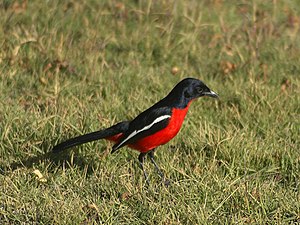Red-bellied shrike
| Red-bellied shrike | ||||||||||||
|---|---|---|---|---|---|---|---|---|---|---|---|---|

Red-bellied Shrike ( Laniarius atrococcineus ) |
||||||||||||
| Systematics | ||||||||||||
|
||||||||||||
| Scientific name | ||||||||||||
| Laniarius atrococcineus | ||||||||||||
| ( Burchell , 1822) |
The breasted shrike ( Laniarius atrococcineus ) is a species in the genus Lanarius in the family of bushshrike (Malaconotidae). In the past they were assigned to the family of the shrike (Laniidae), today they form a family of their own.
Appearance
The red-bellied shrike is strikingly black and red in color. Both sexes are colored the same. Its entire underside is carmine red, the upper side is black with white vertical stripes on the wings. The bill and legs are also colored black. Since the colors black-white-red reminded the German colonists of that time in southern Africa of the imperial flag, the animal has also been called the imperial bird since that time .
The young birds are yellow-brown with dark horizontal stripes. There are also yellow-bellied morphs among the adult birds.
His loud and piercing singing consists of bell-like flute tones, which the red-bellied shrike perform individually or in a duet.
distribution
The red-bellied shrike is widespread throughout Botswana , Namibia , West Zimbabwe and in the West Transvaal and the northern Cape Province of South Africa. Its habitat are bush savannahs and light mopane forests .
Way of life
The red-bellied shrike mostly live in pairs and breed in thorn bushes. Your clutch consists of two to three eggs.
They are known for their singing in the form of a characteristic duet between the two partners. The singing elements are different between the sexes and also differ individually. The functions of singing include both the defense of the territory and the cohesion of the couple - in the sense of a control or "guard".
Their food is insects that they hunt in the bushes and on the ground. That's why you see them more often on the ground.
literature
- Thomas Barlow and Winfried Wisniewski: Southern Africa. South Africa, Namibia, Botswana, discovering animals and plants (Kosmos nature travel guide). Franckh-Kosmos, Stuttgart 1998, ISBN 3-440-07665-2 .
Web links
Individual evidence
- ^ Ian Sinclair, Phil Hockey et al. a .: Birds of Southern Africa . 3. Edition. Struik Nature (Penguin Random House SA), Cape Town, ISBN 978-1-77584-099-2 , pp. 394 .
- ↑ Irene M. van den Heuvel: THE FUNCTION OF DUETTING IN THE CRIMSON-BREASTED SHRIKE (LANIARIUS ATROCOCCINEUS). University of Oldenburg, May 27, 2013, accessed on August 12, 2019 (German, unknown language, English).
- ↑ Irene M. van den Heuvel, Michael I. Cherry & Georg M. Klump: Individual identity, song repertoire and duet function in the Crimson-breasted Shrike (Laniarius atrococcineus) . In: Bioacoustics . tape 22 , no. 1 . Taylor & Francis, 2013, pp. 1-15 .
- ↑ Elke Brüser: Ball of light in the savannah. In: Blog wing flap and quiet step. Retrieved on August 12, 2019 (German).
